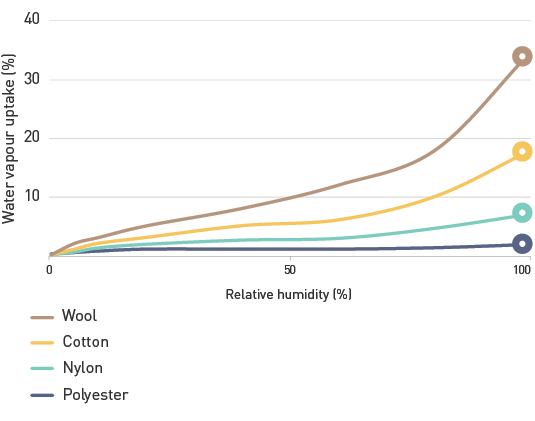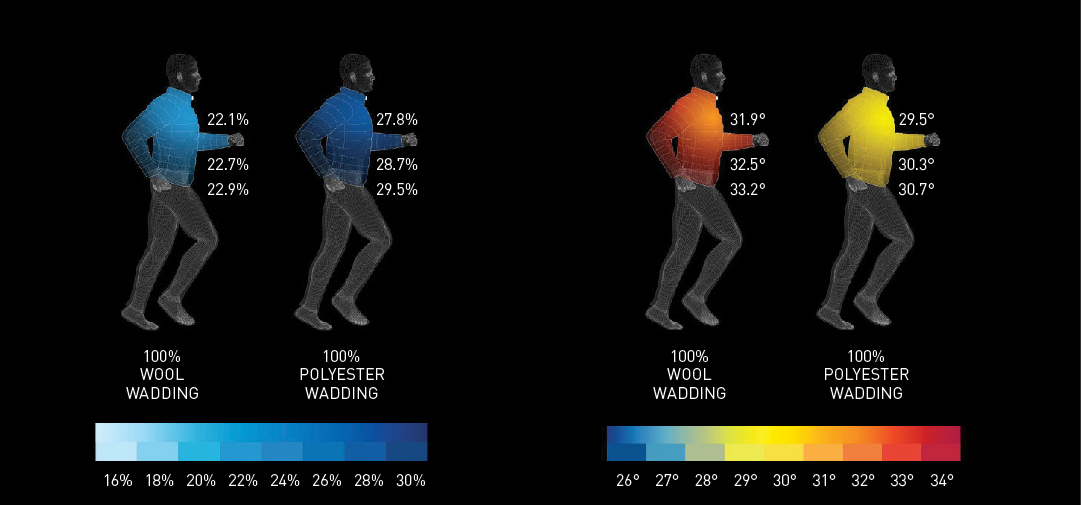Wool fibres are naturally breathable. They can absorb large quantities of moisture vapour and allow it to evaporate, making wool garments feel less clingy and more comfortable than garments made from other fibres.
In contrast to synthetics, wool is an active fibre that reacts to changes in the body’s temperature, keeping the wearer comfortable. Accordingly, wool garments are one of the most breathable of all the common apparel types. Wool’s natural resistance to odour is another key reason why wool wins for activewear.
Effective moisture and temperature management
Wool helps to protect the body against changes in temperature and moisture levels during exercise. Exercise causes the body’s metabolic rate and temperature to increase, and the body responds by initiating cooling mechanisms to maintain its core temperature. As physical exertion can take place in a range of environmental conditions – from skiing in the Arctic to running in a desert – the type of clothing worn has a major impact on the performance and health of the body.

Moisture uptake of wool and other common apparel fibres.
Wool's natural crimp provides superior insulation
The inherent natural 3D crimp of the wool fibre traps pockets of still air, insulating your skin from the cold environment and keeping you warmer. Wool maintains a drier microclimate next to skin, keeping the wearer warm and dry.
Wool reduces post-exercise chill
Wool reduces the rate of skin cooling and the severity of post-exercise chill, which can range from uncomfortable to dangerous. When you stop exercising in very cold conditions, you can experience three times more chilling in synthetic garments than when wearing wool garments. This is due to wool fibre retaining – and only slowly releasing – moisture from within its structure, helping to maintain a higher skin temperature and less rapid cooling.
Unlike most synthetic fibres, wool is hygroscopic. It absorbs water vapour from its surrounding environment far more effectively than other common apparel fibres. Wool can absorb up to 35% of its weight before feeling wet and clinging to the skin. As absorption occurs, wool releases heat, keeping the wearer feeling warmer and drier in cold damp conditions. One kilogram of dry wool can release heat equivalent to an electric blanket running for eight hours.

Wool-filled jackets keep the skin microclimate drier (left) and warmer (right) across the torso, compared to polyester-filled jackets. This has been tested in cold, damp conditions during walking at 5°Celsius/85% relative humidity.
Wool keeps you cooler in hot, dry environments
In warm environments, wool fabrics can feel up to two times cooler to touch than synthetic fabrics, because wool conducts more heat away from your skin. When it is hot and dry, wool keeps you cooler, by transferring moisture vapour away from the skin and allowing it to evaporate. Wool fabrics can move 25% more moisture away from your skin than polyester fabrics, equivalent to an ambient temperature drop of up to four degrees Celsius.
Odour resistance
Wool garments and textiles are naturally odour resistant due to the fibre’s unique properties. Wool’s complex chemical structure enables it to absorb and lock away odours within the fibre, only releasing them upon washing.